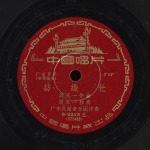Filed under: Instrumental
The Guzheng, and the Guqin, are both descended from the ancient Chinese “Se”, the archetype of all Asian zithers. The instrument spread throughout Asia, carrying it’s pentatonic scale and wobbly vibrato wherever it went. More than the 2000 years old, the Guzheng and it’s relatives have undergone constant modification in terms of construction and number of strings.
One of the main differences between the Guzheng and the Guqin is that Guzheng, like most other Asian zithers, has movable bridges. This allows the player to create the characteristic vibrato by plucking the string with one hand and pressing on the same string but on the other side of the bridge thereby bending the pitch of the note.
Some other Asian zithers, past and present:
Japan: KOTO, WAGON, JUSHICHIGEN, NIJUGEN, SANJUGEN, ZOKUSO, SUMAGOTO
Okinawa: KUTU
Korean: GAYAGEUM, KOMUNGO, AJAENG
Monglolia: YATGA
Vietnam: DAN TRANH, DAN THAP LUC
Here’s a Guzheng piece on the Zhonggou Changpian label, probably from the 1940’s. This label featured a wide array of Chinese music styles, from Folk to Classical to Opera. Interestingly, this label, and the related Art Tune, seem to have been the first to seriously record Chinese music other than opera. The labels I’ve been featuring so far recorded Opera almost exclusively.
Even so, I’ve heard very few Guzheng solos on 78 rpm. This one is titled “Fang Zhi Mang” (Busy with Weaving) and was the only Guzheng piece by composer Liu Tian-Yi, a Cantonese composer and Gaohu player. Here he is playing his own composition.
Special thanks to Bei Bei He, a GuZheng player and teacher in southern California (www.beibeizheng.com) and Hong Wang for their help translating and information about Liu Tian-Yi.
Filed under: Amoy Opera, Instrumental | Tags: amoy, chinese opera, Fujian, Hokkien, Taiwan
Amoy is in the Southeastern province of Fujian, across the strait from Taiwan. The language and culture are closely related to that of Taiwan. Here’s an Amoy Opera instrumental on a label I’ve never seen before. The name of the label translates as something like “Country Love Company”, or maybe more accurately “Patriotsim”, as one commentor has noted below . The music sounds very much like Taiwanese Opera (coming soon in a future post).
JW over at Excavated Shellac has posted a great Cantonese Opera recording this week, so I decided to post some Chinese music that isn’t opera. Here are two records of instrumental music.What would Confucius play? The Guqin, a 7 string zither, is a very old instrument that was associated with philosphers and scholars, and played by Confucius 2500 years ago! The music is very different from the Chinese Opera we’ve been listening to, which is essentially folk music, while the Guqin played meditative art music. This was probably the first instrument to use tablature notation, some of it was written as early as the 12th century. Pretty amazing. A nice cd of old guqin recordings by Lo Ka Ping is available here.
The Sanxian is basically a banjo. It has 3 strings, usually tuned DAD, and a fretless neck. The lack of frets allows for all kinds of great slides and unusual intonation. It’s body is covered with a python skin. Sanxian is used throughout China and there are variations all over South East Asia.
Blind Musicians from Shanghai. Sanxian player in the middle.
Filed under: Instrumental
I’m sure, Gentle Reader, that you’ve now realized my method of surveying Chinese Opera is based on a tour of the different record companies in addition to the different styles. Columbia records was perhaps the most prolific label recording in China, starting just after the turn of the century through the end of the 78 era. Cantonese, Peiping, Teochew and other types of opera were all recorded by Columbia and many of the later records from the late 30’s and 40’s have a much more “westernized” sound than the music posted on this blog. These more modern sounding records are some of my least favorite so I always approach Columbia records with caution!
Traditional Chinese Operas often included instrumental sections, either to entertain between acts or fill time during costumes changes, etc. Instrumentals were rarely recorded, presumably because the opera genre is far more oriented toward the vocalists and the music almost seems to be secondary. Nonetheless, there is a vibrant offshoot of opera music known as “Silk and Bamboo” (Silk referring to strings and Bamboo to woodwinds). This music is usually instrumental and is played in public by amateurs in an informal setting such as a tea house, not unlike Irish pub music sessions. There is still a lively Silk and Bamboo scene today in Shanghai.
This rousing tune is played on the gaohu (similar to erhu), yehu (two string instrument with coconut sound-box, sounds like viola), qin qing (banjo-like instrument.)
(UPDATE: It just occurred to me that this is the well known tune “Rain Dropping on Banana Tree”…I hadn’t noticed because it’s so much faster than the older version I’m familiar with…the older version can be heard on the Rounder cd of the same name.)










